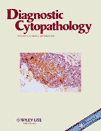Interpretive yields of screening Pap tests and diagnostic Pap tests†
Presented in part in abstract form at the Annual Meeting of the United States and Canadian Academy of Pathology, Vancouver, British Colombia, 2004.
Abstract
Recently, our laboratory has introduced the Medicare classification “diagnostic Papanicolaou (Pap) test” (DPT) for both conventional and liquid-based Pap tests. Because little is known regarding the diagnostic yield of DPT, we review our experience with these tests in a community with a low incidence of squamous intraepithelial lesions and contrast this with our experience with screening Pap tests (SPTs). A search of our laboratory's computerized data system identified all Pap tests classified as SPT and DPT from December 3, 2002 to December 2, 2003. The interpretations were tabulated and statistical comparisons were made. Between December 3, 2002 and December 2, 2003 63,626 Pap tests were interpreted (57,922 SPTs and 5704 DPTs). DPTs were far more likely to yield abnormal results (atypical squamous cells or worse, P < 0.001) and were especially more likely to yield malignant results. These differences have numerous possible implications regarding screening, rescreening, and the design of studies that investigate the screening value of the Pap test. Diagn. Cytopathol. 2004;31:427–429. © 2004 Wiley-Liss, Inc.




